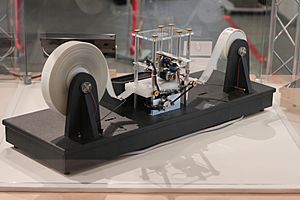Turing machine facts for kids
A Turing machine is a big idea in computer science. It's not a real, physical machine you can touch. Instead, it's a way of thinking about how computers work. It uses a set of rules, different "states" (like modes), and ways to change between them.
The English mathematician and computer scientist Alan Turing first described this idea in 1936. Turing machines help us understand what computers can and cannot do. They are one of the most important models for studying how computers solve problems.
Contents
How a Turing Machine Works
Imagine a very simple computer. A Turing machine has these main parts:
- States: These are like different "modes" or steps the machine can be in. It always starts in a special "start state."
- An Endless Tape: Think of a super long paper strip divided into many small boxes. Each box can hold one symbol.
- A Read/Write Head: This is like a special pointer that can read what's in a box, write a new symbol, and move left or right along the tape.
- Rules: These rules tell the machine what to do next. They depend on what the machine reads and its current state.
Before a Turing machine starts, some symbols (like letters or numbers) are written on its tape. The read/write head looks at the first symbol. Based on what it reads and its current state, the machine follows a rule. This rule might tell it to:
- Write a new symbol over the old one.
- Move the head one box to the left or right.
- Change to a new state.
This process repeats until the machine reaches a special "stop" state.
Turing Machines and Problems
Turing machines are used to understand two main things:
Deciding if Something Fits a Rule
Sometimes, a Turing machine is used to figure out if a certain "word" or piece of information follows a specific rule. For example, does a word belong to a certain "language" (a set of words that follow rules)?
For this, the machine has two special states: "Accept" and "Reject." If the input fits the rule, it reaches the "Accept" state and stops. If it doesn't, it reaches the "Reject" state and stops. If the machine always stops and gives an answer, it "decides" the rule.
Calculating Answers
A Turing machine can also be used to calculate answers to mathematical problems. When used this way, it usually has just one "end state." When the machine reaches this state, it stops. The answer to the problem will then be written on the tape.
Why Turing Machines Are Important
Turing machines were not meant to be built as real computers. But they are super important for understanding how computers work. They are one of the simplest ideas that can do everything a modern computer can do.
The Church-Turing thesis is a big idea in computer science. It says that any problem a computer can solve can also be solved by a Turing machine. This helps scientists figure out if a problem can be solved by any computer at all. If a Turing machine can't solve it, then no computer can!
Different Kinds of Turing Machines
There are a few variations of Turing machines, but they all have the same basic power:
- Multiple Tapes: Some Turing machines can have more than one endless tape and more than one read/write head. Even though they seem more powerful, scientists have shown they can't solve any problems that a single-tape machine can't. They just might solve them faster!
- Nondeterministic Machines: In a regular Turing machine, for each state and symbol, there's only one rule to follow. A "nondeterministic" machine might have several possible rules to choose from. It's like it can try all paths at once! This doesn't make them more powerful, but it might make them solve some problems much, much faster. Scientists are still studying how much faster they can be.
- Universal Turing Machine: This is a special kind of Turing machine. It's like a "master" Turing machine that can pretend to be *any other* Turing machine. You give it the rules of another Turing machine as input, and it can then act just like that machine. This is a bit like how a modern computer can run any program you give it.
Images for kids
-
A Turing machine built using Lego bricks!
See also
 In Spanish: Máquina de Turing para niños
In Spanish: Máquina de Turing para niños






